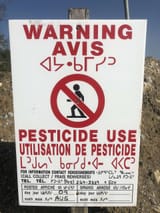Plants that survive the initial glyphosate spray show strange mutations. Small amounts of the chemical have been detected years later in their leaves, fruit, flowers and roots, [4] which are food sources for a wide variety of wildlife.
The conifer forest planted after the glyphosate spray doesn’t provide the same range of habitat as a mixed forest. [5] It is hotter and drier, and more prone to devastating forest fires. [6] It also absorbs and stores less carbon. [7]
As our planet warms, we can anticipate devastating increases in climate-exacerbated weather events. Forest fire researchers project that “fire weather” will increase 50% in Western Canada and 300% in Eastern Canada by the end of the century. [8]
We must preserve mixed forests which serve as key natural resources that dampen the impact of forest fires.
Despite efforts by Monsanto [9], a growing body of scientific evidence has linked glyphosate to very serious human health problems. High glyphosate exposure is found to lead to a significant increase in specific types of cancer. [10] Consuming foods with so-called “safe” levels of glyphosate kills off beneficial gut bacteria, which can lead to a wide range of health issues including chronic disease and mental health problems. [11] Glyphosate acts as an endocrine (hormone) disruptor and is linked with a higher risk of birth defects, miscarriages, and a range of fertility and reproductive problems in men and women. [12]
